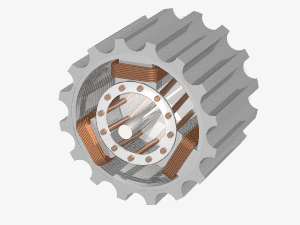AC Motors are electrical machines that convert electrical energy (supplied in the form
of sinusoidally time varying or "alternating" current) to rotational mechanical energy by the
interaction of magnetic fields and conductors. Unlike motors that run directly on a DC current,
AC motors generally do not require brushes and commutators.
AC Motors can be broadly classified into two categories:
- Asynchronous / Induction Motors
- Synchronous Motors
Asynchronous or Induction Motors: These motors
consist of a stator with a winding capable of producing a rotating magnetic
field, and a rotor with a shorted conductor winding in which a current is induced by
the rotating magnetic field. The fields generated by the current induced in the
rotor generate a restoring torque responsible for the rotation of the rotor.
The rotating magnetic field produced by the stator is easily set up using a multi-phase AC supply.
The term "asynchronous" refers to the fact that the rotation
of the rotor is always slower than the rotational speed of the magnetic field.
The difference in speed of the field and the rotor is called 'slip' and the torque
of the motor is proportional to this slip.
Thus, the rotational speed of the motors depends on both the excitation frequency and the load.

The synchronous speed, or the theoretical maximum speed of an
induction motor is a function of the supply frequency (e.g. often 60 Hz in the US) and the
number of poles. The figure on the left shows a simple 3 phase, 3 pole induction motor.
Induction motors are often
called 'squirrel cage' motors due to the rotor winding design.
An induction motor starts with maximum slip and has a
tendency to draw
a very high current initially, especially if starting at a high load. This results in the need to have
a separate starting mechanism. In case of single phase AC motors,
the rotor needs to be set in motion initially to start the motor. This is accomplished by using a mechanical
starting force or employing a separate starter winding.
Synchronous Motors: The rotor in synchronous AC motors rotates in synch with the excitation field (i.e. there is no "slip"). The magnetization of the rotor is produced by a permanent magnet in brushless designs or by windings with an AC current supplied through slip rings or brushes (large, high-power motors).
These motors maintain a constant speed at all loads. When the load exceeds the rated load, the motor 'pulls out' of synchronism and ceases to operate. As these motors operate at a fixed speed (that can be adjusted by varying the supply frequency), they are suitable for precision drives where accurate speed control is required.
Synchronous motors can be made to operate at different power factors based on rotor excitation. It is common to use a synchronous motor as a synchronous condenser by over exciting the rotor, causing it to operate on a leading power factor. By using such a synchronous condenser, the overall power factor, of a manufacturing plant for example, can be improved.
Since these motors only operate at synchronous speed, a separate starting arrangement is required. In most cases a 3 phase synchronous motor will be started as an induction motor (by shorting the rotor winding) and then switched into synchronous mode.

